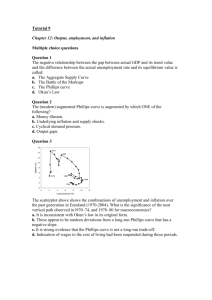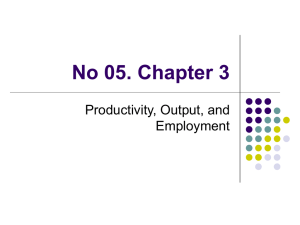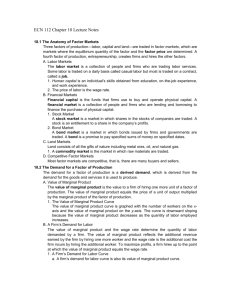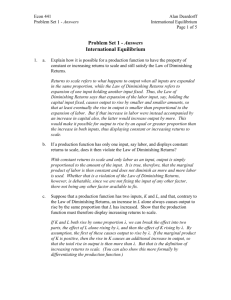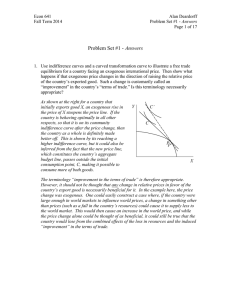Word
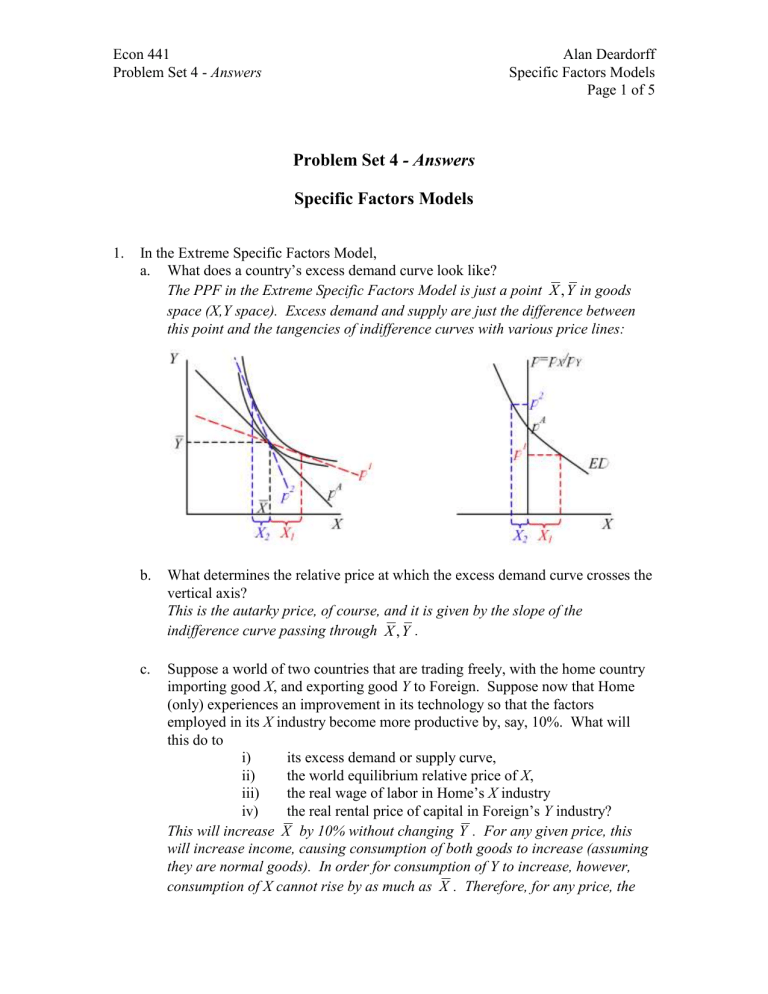
Econ 441
Problem Set 4 - Answers
Problem Set 4 - Answers
Specific Factors Models
1.
In the Extreme Specific Factors Model, a.
What does a country’s excess demand curve look like?
Alan Deardorff
Specific Factors Models
Page 1 of 5
The PPF in the Extreme Specific Factors Model is just a point X , Y in goods space (X,Y space). Excess demand and supply are just the difference between this point and the tangencies of indifference curves with various price lines: b.
What determines the relative price at which the excess demand curve crosses the vertical axis?
This is the autarky price, of course, and it is given by the slope of the indifference curve passing through X , Y . c.
Suppose a world of two countries that are trading freely, with the home country importing good X , and exporting good Y to Foreign. Suppose now that Home
(only) experiences an improvement in its technology so that the factors employed in its X industry become more productive by, say, 10%. What will this do to i) its excess demand or supply curve, ii) the world equilibrium relative price of X , iii) the real wage of labor in Home’s X industry iv) the real rental price of capital in Foreign’s
Y industry?
This will increase X by 10% without changing Y . For any given price, this will increase income, causing consumption of both goods to increase (assuming they are normal goods). In order for consumption of Y to increase, however, consumption of X cannot rise by as much as X . Therefore, for any price, the
Econ 441
Problem Set 4 - Answers
Alan Deardorff
Specific Factors Models
Page 2 of 5 country’s excess supply of X increases and its excess demand decreases, shifting its ED curve to the left throughout its length, as shown below. This, in turn, causes the world equilibrium relative price of X to fall, as also shown.
p=p
X
/p
Y
ES*
p
*
p
*’
ED’
ED
X
In the Home X industry, labor is paid the value of its marginal product. That marginal product has increased by 10% due to the improved technology, so labor’s wage in units of X has gone up by that amount. However, the price of X has fallen, and we don’t know by how much. If the price falls by less than 10%, then this is necessarily an improvement in its real wage. But if it falls by more than 10%, which it may (depending on the elasticities of the various curves), then workers in the Home X industry can buy less of Y, and may be made worse off if their demand for Y is a large enough part of their budgets. Thus the effect on the wage in the Home X industry is ambiguous.
As for capital in the Foreign Y industry, its marginal product has not changed, so it is paid the same in terms of Y. But that payment is worth more in terms of
X, due to the price change, so its real payment has increased.
2.
In the (Standard) Specific Factors Model of a small open economy that initially exports good X , analyze the effects on i) outputs of the goods, X and Y , ii) the real wage of labor, iii) the real rental price of capital in the X industry, and iv) the quantity of X exported due to the following changes (one at a time): a.
A fall in the price of good Y , holding the price of good X constant.
The fall in price of good Y causes the Y industry’s value of marginal product of labor curve, VMP
LY
=p
Y
MP
LY
, to shift down, as shown below. Labor market equilibrium is found at a lower nominal wage, w’, with an increase in the amount of labor employed in the X industry and a decrease in L
Y
. Therefore, output of X rises and output of Y falls, moving the country down and to the right on its PPF.
w
X
Econ 441
Problem Set 4 - Answers
Alan Deardorff
Specific Factors Models
Page 3 of 5
The effect on the real wage is ambiguous. It has fallen in nominal terms, and therefore with respect to the price of X, which has not changed. But the price of
Y has fallen, and the wage would have to have fallen to w
0
shown below to equal that fall in price (since that is the amount that the p y
MP
LY
curve has fallen), and it hasn’t done that. So w/p
X
is down, but w/p y
is up.
w
Y
Y
C’
C
w
w
0
Q
Q’
O
X
p
Y
MP
LY
p
X
MP
LX
p
Y
’MP
LY
L
X
L
X
’ O
Y
Nominal payments to capital in the X industry have increased, since the increase in L
X
increases capital’s marginal product (or note the increased area below
VMP
LX
above w’). Since p
X
is unchanged and p
Y
has fallen, this is a real increase.
Looking at output and consumption in the PPF diagram, we see that output of X has increased, while consumption of X may have risen or fallen (it is shown having risen) depending on income and substitution effects. Without any assumption about preferences, we can’t be sure that exports of X increase. b.
An increase in the size of the labor force.
This expands the diagram horizontally, since its horizontal dimension is the labor endowment. It is drawn below keeping the O
X
origin fixed, and therefore shifting to the right both the right-side vertical axis and the VMP
LY
curve, since that is drawn with respect to that axis. The result is that the intersection with the unchanged VMP
LX
curve also moves right, but not as much, and occurs at a lower w.
This fall in the wage, holding prices and capital stocks fixed, requires a fall in the marginal product of labor and therefore that employment expands in both industries. Thus output rises in both industries. The fall in the wage is a real decline, since both prices are fixed. And the increased employment increases the returns to capital in both sectors, also in real terms since prices are fixed.
X
w
X
Econ 441
Problem Set 4 - Answers
Alan Deardorff
Specific Factors Models
Page 4 of 5
Here again we cannot be sure what happens to exports, since both production and consumption of X expand.
w
Y
w
Y
Y
C’
Q’
C
w
w’
VMP
LY
O
X
Q
(VMP
LY
)’ VMP
LX
O
Y
O
Y c.
Destruction of a part of the capital stock employed in the Y industry.
This reduces the marginal product of labor in the Y industry, shifting the VMP
LY curve down. The labor-market diagram looks the same as in part (a), except that the curve has shifted due to changing the MP
LY
function instead of changing p
Y
. This time, however, the PPF is shrunken inward, since less of Y (but not X) can be produced. In fact, from the labor-market diagram we see again that since L
X
increases, output of X rises. Output of Y falls, of course, both because of the loss of capital and then also because of the fall in L
Y
as labor also leaves the industry.
X
w
X
w
Y
Y
C’
C
Q
w
Q’
O
X
p
Y
MP
LY
p
X
MP
LX
p
Y
MP
LY
’
L
X
L
X
’ O
Y
The real wage falls, because the nominal wage falls and prices have not changed.
X
Econ 441
Problem Set 4 - Answers
Alan Deardorff
Specific Factors Models
Page 5 of 5
Capital that survives in the Y sector actually gains, though this is a bit hard to see. Since w has fallen with no change in p
Y
, MP
LY
must have fallen. But marginal products depend on the ratio of capital to labor, so K
Y
/L
Y
must have fallen. This in turn means that MP
KY
must have risen, and therefore that r
Y
has gone up. Since p
X
is also unchanged, this is a real increase.
This time we can say what happens to exports. The fall income reduces consumption of X (if X is normal), while the output of X has increased.
Therefore exports of X rise.
3.
The figure below shows an initial production equilibrium in the (standard) Specific
Factors Model. It differs from what we usually assume, however, in that the marginal product of labor in the Y-industry is assumed to drop to zero at a certain industry size, and the initial equilibrium has it at that size. a) Show what the production possibility frontier looks like for this economy, where on the PPF it is operating in this initial equilibrium, and what the budget line of consumers in the aggregate must look like.
The PPF is now kinked as shown at the right by the curve AQB. That is, it is horizontal at output A out to point Q, then curved like a normal PPF down to some point B on the horizontal axis. It is initially operating at the kink, so the budget line of consumers is the straight line DQE reflecting the initial prices. b) Suppose now that the relative price of good Y, p
Y
, rises. What will happen to outputs of X and Y and to the real wage of labor?
The rise in price shifts up the p
Y
MPL
Y
curve as shown, but this does not move its vertical portion. Thus the intersection with p
X
MPL
X
is unchanged and the nominal wage remains at its initial level.
However, since the price of one of the goods has risen
Econ 441
Problem Set 4 - Answers
(and the other has not changed), the real wage is reduced.
Alan Deardorff
Specific Factors Models
Page 6 of 5


